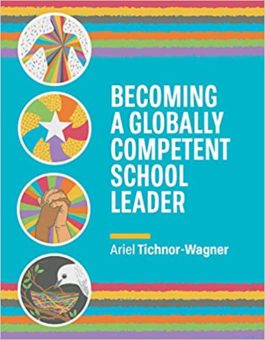Becoming a Globally Competent School Leader
Becoming a Globally Competent School Leader
By Ariel Tichnor-Wagner
(ASCD, 2020 – Learn more)

The COVID-19 pandemic brought the world to a halt. The stay-at-home mandate in the spring of 2020 compelled me to think differently about reaching and teaching my students.
With trips to London and elsewhere cancelled, I pivoted from thinking about how to bring my students out into the world to reflecting more on how I could improve my practice of bringing the world into my classroom.
Becoming a Globally Competent School Leader by Ariel Tichnor-Wagner provided a framework for that reflection and inspired me to think strategically about strengthening and scaling this important work in my own practice and that of my faculty colleagues.
Companion Guide for Administrators

What is Global Competency?
Global competence is the anticipated outcome of curriculum and educational programming that recognizes the challenges and opportunities of our 21st century world. This integrative set of skills, knowledge, and dispositions contributes towards a perspective that will allow students not only to navigate the world but, more importantly, to actively engage with it.
The Case for Global Competency
The 21st Century has already been marked by an increasing connectivity of people, agencies, and governments. With advances in technology, educators are preparing students for a world that cannot yet be imagined – for jobs and fields that haven’t even been dreamed of yet. Curricula must be relevant for the world that students operate in today while likewise preparing them to participate in the global society of tomorrow.
Tichnor-Wagner forecasts that this future reality will be one in which relationships, empathy, perspective, collaboration, and the ability to think critically and creatively will be key. This framework of global competency hinges on a balance of social-emotion and academic learning goals and includes a relevant curriculum of content, skills, and dispositions that students will need to thrive in and meaningfully contribute to a diverse, global society.
Defining Globally Competent Instruction
Throughout the introduction, Tichnor-Wagner includes several helpful tables. These at-a-glance charts present social-emotional, cognitive, and behavioral global competence learning outcomes and synthesize twelve core teaching elements of dispositions, knowledge, and skills.
Most critically, Tichnor-Wagner alludes to three “signature pedagogies” of globally competent instruction that transcend the teaching elements and can be applied to any classroom including:
- Integrating global issues and perspectives into everyday instruction;
- Authentically engaging students with issues, people, and places beyond their cultural affiliations and national borders; and
- Connecting their own experiences and those of their students to the curriculum” (Tichnor-Wagner, 2020).
Starting and Scaling: A Vision of Leadership
Educational leadership is about more than making the trains run on time; it is about recognizing the efficiency of the train but planning for an airport. In other words, leaders can, and should, be visionary; however, leaders must balance aspiration with intentional steps towards implementation. Tichnor-Wagner’s definition of leadership is one in which leaders dream and plan, but is also one characterized by taking action.
Tichnor-Wagner identifies seven tenets of what leadership looks like and applies these indicators to the framework of creating and sustaining a culture of global competency:
- facilitating a shared mission and vision;
- supporting curriculum, instruction, and assessment;
- fostering a collaborative professional community;
- connecting and collaborating;
- advocacy and community engagement;
- managing school operations and resources; and
- cultivating an inclusive, caring, and supporting school community.
Tichnor-Wagner also outlines four domains of educational leadership. These domains include alignment, integration of local needs and overarching vision; will, getting key stakeholders on board; resources, the allocation of time, money, and materials; and, capacity, creating a culture of continuing education by providing ongoing professional learning opportunities.
Each of the central chapters zeroes in on one of the four domains of leadership and invites readers to consider how to apply the seven leadership indicators in that domain.
Consistent Chapter Framework
Tichnor-Wagner’s presentation of a global competency framework provides an opportunity for introspection, planning, and action.
Each chapter begins with an exploration of the domain through the lens of global competency. Along the way, readers encounter vignettes of how other school leaders have implemented programs in their schools.
In the chapter on resources, Tichnor-Wagner shares ideas of how other schools worked within existing budgets to advance the goal of global competency through hiring staff, accessing curriculum, or targeting professional development.
As I reflected on these examples, it provided me an opportunity to consider the existing initiatives and programs at my school while also inspiring ideas for continued growth.
For example, my school created a summer sabbatical program for faculty to support their pursuit of a rich professional learning experience that would impact their teaching. Over the past five years, this program has supported faculty exploring Shakespeare with the actors of London’s Globe Theatre and participating in an archeological dig of a Roman fort in Italy, among other projects.
Likewise, we’ve increased the range of our travel programs for students and have made financial assistance available to provide more students the opportunity to participate. Even the focus of these trips has shifted with experiences aimed at greater community interaction and collaboration. In the past five years, groups have engaged with organizations in Peru, Ecuador, Costa Rica, and Panama and recently collaborated with other schools in a choir festival in Vatican City to sing for Pope Francis.
The chapters conclude with possible action items that leaders can take to transform intent into implementation. These examples are nested under the seven leadership tenets. In this way, Tichnor-Wagner builds on the theme that global competence is not something that leaders need to add to an already full-plate; rather, global competence is a presence of mind and call to action that can be integrated into the best practices of school leadership. These examples are then followed up with reflection and action questions that can guide further introspection and dialogue.
Charting a Map for the Journey Ahead
Becoming a Globally Competent School Leader is a valuable resource for initiating a personal and programmatic self-study. The reflection questions and call to action invite introspection and provide starting points for discussion with stakeholders. School leaders should first define global competence and then articulate how it operates through the prism of the school’s mission statement. This dialogue will allow leaders to guide discussions on reviewing and evaluating current initiatives as well as developing a strategic plan for sustaining and scaling this work. This kind of thinking and planning will allow the school community to act: implementing its vision of global competency with intention and purpose.
Michael McLaughlin is the Head of Middle School at Austin Preparatory School in Reading, Massachusetts. McLaughlin loves travel (he’s visited 19 countries) and has served on the faculty with the Independent Schools Cultural Alliance in the United Kingdom. The 2019 recipient of the A+ Administrator Award from the New England League of Middle Schools, McLaughlin is also a curriculum author for the Sophia Institute Press, a guide with the National Geographic Educator Certification program, and a freelance travel writer.

































